542. Common Square-tailed Drongo Dicrurus ludwigii (Kleinbyvanger)
Order: Passeriformes. Family: Dicruridae
Taxonomic Note:
Name change from Square-tailed Drongo to Common Square-tailed Drongo follows split of Western Square-tailed Drongo (D. occidentalis).
Description
19 cm. An all black glossy bird with a shallow forked tail. It has ruby-red eyes. The legs and feet are black.
Female is duller black than male.
Juvenile resembles female but has pale tips to the feathers.
Similar species: Smaller than the Fork-tailed Drongo, lacks the pale wing patches and the tail is only slightly notched. It differs from Southern Black Flycatcher by its smaller, rounder head, and red (not dark brown) eye that can be seen at close range. It also flicks its wings, especially when agitated. It may be distinguished from larger male Black Cuckooshrike by its slightly notched tail and the lack of both a yellow shoulder and an orange-yellow gape.
Distribution
In southern Africa, it is locally common in Mozambique bordering on Zimbabwe, eSwatini, Limpopo Province and coastal areas of KwaZulu-Natal, marginally extending into the Eastern Cape.
Habitat
Evergreen forests. It generally prefers closed canopy evergreen woodland with sporadic clearings, also occurring in gallery forest along watercourses and alien Eucalyptus plantations with indigenous undergrowth.
Diet
Insects. It eats a wide variety of mostly large insects, often hunting from a perch on the border of a clearing, hawking its prey aerially. It also forages in mixed-species flocks, sometimes stealing the food caught by other birds (a behaviour known as kleptoparasitism).
Breeding
Monogamous and territorial. Both sexes help build the nest. The nest is a well-built cup made of leaf petioles, twigs, tendrils, fibres and lichen, bound together with strands of spider web. It is usually suspended between the two branches of a fork in a tree, often near the edge of thick forest. Egg-laying season is from September-January, peaking from October-November. Two to three eggs are laid.
Call
A strident cheweet-weet-weet or a loud cheritl cheritl and other phrases.
Listen to Bird Call: http://www.xeno-canto.org/species/Surniculus-lugubris
Status
Locally common resident in favoured habitat.
Africa Wild Bird Book
Common Square-tailed Drongo
Dewi
What is the good of having a nice house without a decent planet to put it on? (H D Thoreau)
What is the good of having a nice house without a decent planet to put it on? (H D Thoreau)
Common Square-tailed Drongo Photos
542. Common Square-tailed Drongo Dicrurus ludwigii (Kleinbyvanger)
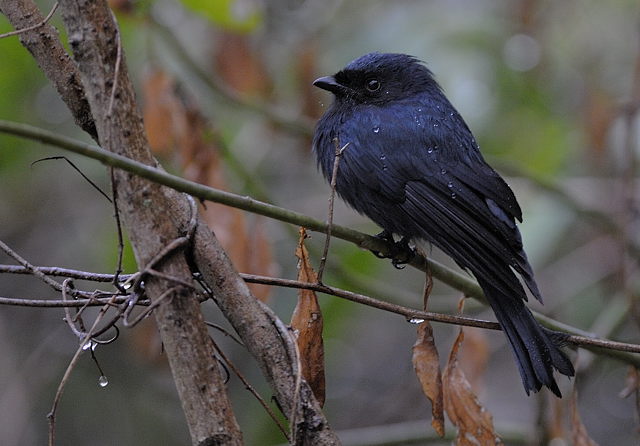
Links:
Species text in The Atlas of Southern African Birds
Sabap2

Links:
Species text in The Atlas of Southern African Birds
Sabap2
Dewi
What is the good of having a nice house without a decent planet to put it on? (H D Thoreau)
What is the good of having a nice house without a decent planet to put it on? (H D Thoreau)
- Mel
- Global Moderator
- Posts: 28240
- Joined: Sat May 19, 2012 12:31 pm
- Country: Germany
- Location: Föhr
- Contact:
Fork-tailed Drongo
541. Fork-tailed Drongo Dicrurus adsimilis (Miksterbyvanger)
Order: Passeriformes. Family: Dicruridae
Descpription
The only all-black perching bird in the region to have a deeply forked tail. Glossy black plumage. Longish, deeply forked tail. Tail often appears double-forked during moult. In flight wings are pale and translucent. Sexes are alike.
Juvenile is dull black with grey mottling on the underparts. Yellow gape visible, but not prominent.
Similar species: Differs from all similar black birds in prominent forked tail, the outer feathers splayed outwards. Most likely to be confused with Southern Black Flycatcher but larger; more deeply forked tail, more robust bill and red (not brown) eye diagnostic. It perches with legs flexed, belly on branch (Southern Black Flycatcher often perches high on legs). Southern Black Flycatcher is smaller, with less robust bill lacking hooked tip. Forehead steeper; tail square (not forked), and eyes brown (not red).
Larger than Square-tailed Drongo, with more deeply forked tail; inhabits open woodland (Square-tailed Drongo inhabits forest).
Distribution
Occurs across sub-Saharan Africa, absent only from extremely arid areas. In southern Africa it is common and widespread, with massive populations in Botswana, Zimbabwe, Mozambique, Namibia and South Africa apart from most of the west coast and the interior of the country.
Habitat
Occurs in a wide variety of habitats with trees but avoids the interior of forests and open habitats without trees.
Diet
Highly adaptable, it eats a variety of animal prey, especially insects but also other birds and fish. It often hawks insects from a perch, catching them in flight or on the ground, often targeting insects flying around electric lights. It is a kleptoparasite, regurlarly stealing food from other birds (often within a mixed-species foraging flock) and mammals. A good example is the Meerkat: In the Kalahari Desert, drongos sometimes perch above a few foraging Meerkats, waiting till one of them finds food, at which point it mimicks their alarm call, snatching up their prey in the ensuing confusion.
Breeding
Monogamous. The nest is a thinly-walled cup made of twigs, leaf petioles and tendrils, strongly bound together with spider web strands. It is usually placed like a hammock between the branches of a tree fork, roughly 4-6m above ground. Egg-laying season is from August-January, peaking from September-October. It lays 2-5 eggs, which are incubated by both sexes for about 15-18 days. The chick are fed and brooded by both parents, leaving the nest after about 16-22 days.
Only known regular host of African Cuckoo.
Call
Loud repetitive twik; also jumble of 'unoiled wagonwheel' creaks and rasping notes. Mimics other bird calls, especially Pearl-spotted Owlett. Listen to Bird Call.
Status
Widespread and common resident, generally sedentary and found singly or in pairs.
Order: Passeriformes. Family: Dicruridae
Descpription
The only all-black perching bird in the region to have a deeply forked tail. Glossy black plumage. Longish, deeply forked tail. Tail often appears double-forked during moult. In flight wings are pale and translucent. Sexes are alike.
Juvenile is dull black with grey mottling on the underparts. Yellow gape visible, but not prominent.
Similar species: Differs from all similar black birds in prominent forked tail, the outer feathers splayed outwards. Most likely to be confused with Southern Black Flycatcher but larger; more deeply forked tail, more robust bill and red (not brown) eye diagnostic. It perches with legs flexed, belly on branch (Southern Black Flycatcher often perches high on legs). Southern Black Flycatcher is smaller, with less robust bill lacking hooked tip. Forehead steeper; tail square (not forked), and eyes brown (not red).
Larger than Square-tailed Drongo, with more deeply forked tail; inhabits open woodland (Square-tailed Drongo inhabits forest).
Distribution
Occurs across sub-Saharan Africa, absent only from extremely arid areas. In southern Africa it is common and widespread, with massive populations in Botswana, Zimbabwe, Mozambique, Namibia and South Africa apart from most of the west coast and the interior of the country.
Habitat
Occurs in a wide variety of habitats with trees but avoids the interior of forests and open habitats without trees.
Diet
Highly adaptable, it eats a variety of animal prey, especially insects but also other birds and fish. It often hawks insects from a perch, catching them in flight or on the ground, often targeting insects flying around electric lights. It is a kleptoparasite, regurlarly stealing food from other birds (often within a mixed-species foraging flock) and mammals. A good example is the Meerkat: In the Kalahari Desert, drongos sometimes perch above a few foraging Meerkats, waiting till one of them finds food, at which point it mimicks their alarm call, snatching up their prey in the ensuing confusion.
Breeding
Monogamous. The nest is a thinly-walled cup made of twigs, leaf petioles and tendrils, strongly bound together with spider web strands. It is usually placed like a hammock between the branches of a tree fork, roughly 4-6m above ground. Egg-laying season is from August-January, peaking from September-October. It lays 2-5 eggs, which are incubated by both sexes for about 15-18 days. The chick are fed and brooded by both parents, leaving the nest after about 16-22 days.
Only known regular host of African Cuckoo.
Call
Loud repetitive twik; also jumble of 'unoiled wagonwheel' creaks and rasping notes. Mimics other bird calls, especially Pearl-spotted Owlett. Listen to Bird Call.
Status
Widespread and common resident, generally sedentary and found singly or in pairs.
God put me on earth to accomplish a certain amount of things. Right now I'm so far behind that I'll never die.
- Mel
- Global Moderator
- Posts: 28240
- Joined: Sat May 19, 2012 12:31 pm
- Country: Germany
- Location: Föhr
- Contact:
Fork-tailed Drongo Photos
541. Fork-tailed Drongo Dicrurus adsimilis
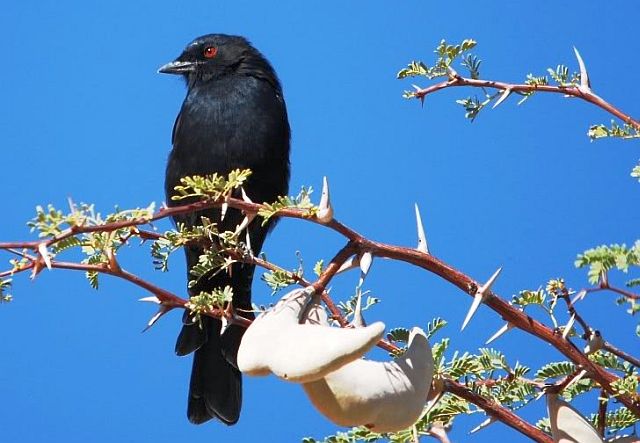 © Mel
© Mel
Kgalagadi Transfrontier Park
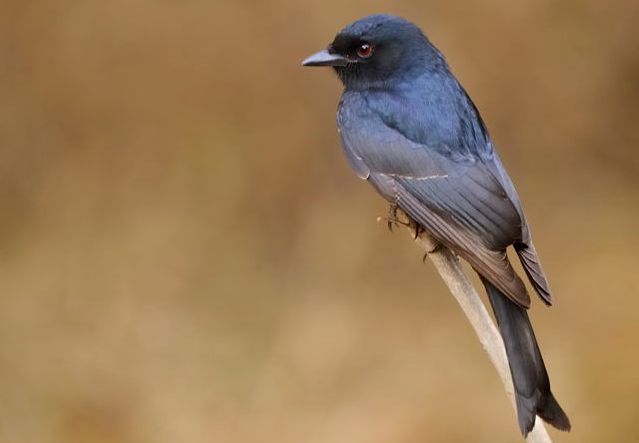 © Dewi
© Dewi
 © Mogggiedog
© Mogggiedog
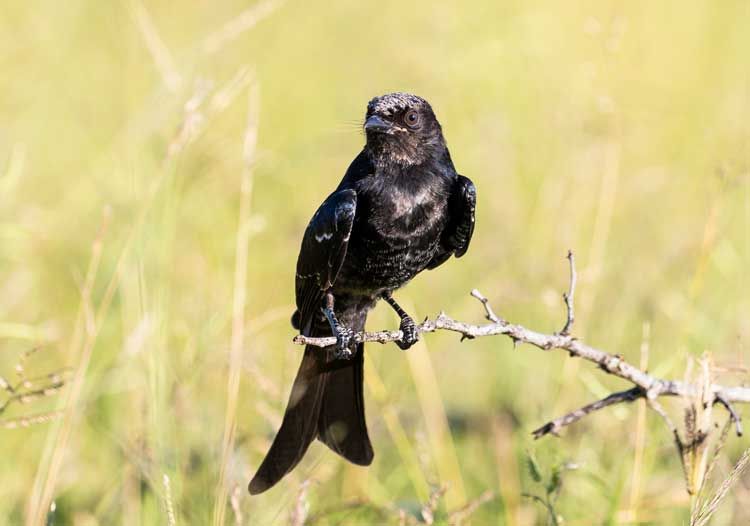 © Pumbaa
© Pumbaa
Juvenile, Kruger National Park, Feb 2020
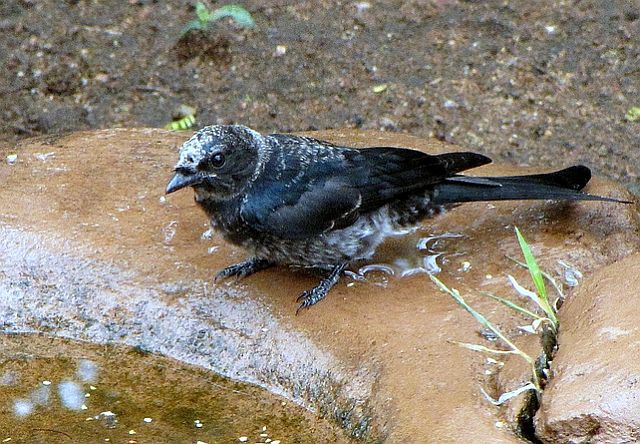 © Lisbeth
© Lisbeth
Juvenile
 Juvenile © BluTuna
Juvenile © BluTuna
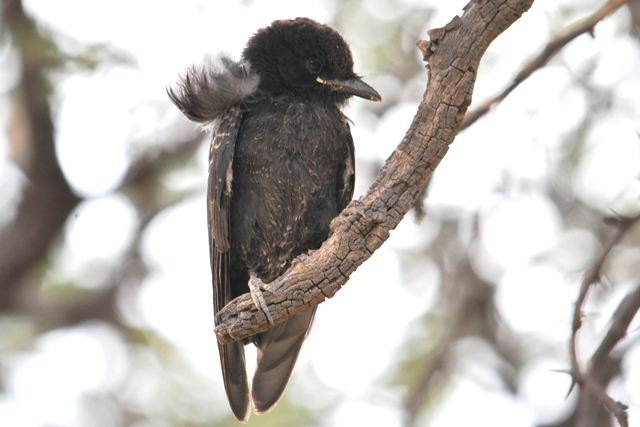
Juvenile in moult
Links:
Species text in The Atlas of Southern African Birds
Sabap2
Fork-tailed drongos use deceptive mimicked alarm calls to steal food
 © Mel
© MelKgalagadi Transfrontier Park
 © Dewi
© Dewi © Mogggiedog
© Mogggiedog © Pumbaa
© PumbaaJuvenile, Kruger National Park, Feb 2020
 © Lisbeth
© LisbethJuvenile
 Juvenile © BluTuna
Juvenile © BluTuna
Juvenile in moult
Links:
Species text in The Atlas of Southern African Birds
Sabap2
Fork-tailed drongos use deceptive mimicked alarm calls to steal food
God put me on earth to accomplish a certain amount of things. Right now I'm so far behind that I'll never die.
Family Monarchidae (Monarch Flycatchers)
The monarch flycatchers (Monarchidae) comprise a family of passerine birds which includes boatbills, shrikebills, paradise flycatchers, and magpie-larks.
Monarchids are small insectivorous songbirds with long tails. They inhabit forest or woodland across sub-Saharan Africa, south-east Asia, Australasia and a number of Pacific islands.
The monarch flycatchers are a diverse family of passerine birds that are generally arboreal. They are mostly slim birds and possess broad bills. The tails are generally long and spectacularly so in the paradise flycatchers in the genus Terpsiphone. Sexual dimorphism in plumage can be subtle or striking.
The monarch flycatchers have a mostly Old World distribution. In the western end of their range they are distributed through sub-Saharan Africa. They also occur in South and Southeastern Asia and most of Australia.
The paradise flycatchers of the genus Terpsiphone range across Africa and Asia, as well as a number of islands. The other paradise flycatcher genus, Trochocercus, is restricted to Africa. The remaining genera are predominately found in Asia, in the Austro-Papuan and Oceania regions. The majority of the family is found in forest and woodland habitats. Species that live in more open woodlands tend to live in the higher levels of the trees but, in denser forest, live in the middle and lower levels. Other habitats used by monarch flycatchers include savannah and mangroves.
The majority of monarch flycatchers are resident, although the African Paradise Flycatcher makes a series of poorly understood intra-African migratory movements.
The paradise flycatchers (Genus Terpsiphone) have the widest distribution of any of the monarch flycatchers, ranging across sub-Saharan Africa, the Indian Subcontinent, Southeast Asia and East Asia. A few species are migratory, but the majority are resident. The most telling characteristic of the genus is the long tail streamers of the males of many species. In addition to the long tails the males and females are sexually dimorphic and have rufous, black and white plumage. The paradise flycatchers are generally small birds, around 18–21 cm in length and weighing 12–23 g. They have a medium length grey or blueish bill which is broad and hooked at the end and is surrounded by stiff rictal bristles. The inside of the mouths of paradise-flycatchers are brightly coloured, being either yellow or green. The tails are long, particularly in many species where the male has a massively elongated pair of middle tail feathers. The function of the long tail is assumed to be related to sexual selection, with females choosing males based on the length of the tail. In most species the tail is longer than the wing, even in the shorter tailed females. The eye is surrounded by an eyering that is a blue thin wattle (slightly more pronounced in some species like the Rufous Paradise Flycatcher).
The paradise flycatchers are, as their name suggests, insectivores, feeding on a variety of insects, usually obtained on the wing. They use a variety of foraging techniques, including hawking from a perch, sallying, hovering, gleaning, and flush-pursuiting.
Paradise flycatchers, like all monarch flycatchers, are monogamous and are generally territorial, although in some cases birds may nest close together and defend the nests together against predators. Females apparently select males based on their tail length, a form of sexual selection. Paradise flycatchers are unusual as exaggerated sexual traits are usually found in promiscuous birds, not monogamous ones. The nests of this genus are neat deep cups placed on a branch or twig, often in a fork. They are usually placed 1–3 m off the ground. They are often very conspicuous, particularly when the long-tailed males are incubating. The nests are, however, aggressively defended by the pair.
Monarchids are small insectivorous songbirds with long tails. They inhabit forest or woodland across sub-Saharan Africa, south-east Asia, Australasia and a number of Pacific islands.
The monarch flycatchers are a diverse family of passerine birds that are generally arboreal. They are mostly slim birds and possess broad bills. The tails are generally long and spectacularly so in the paradise flycatchers in the genus Terpsiphone. Sexual dimorphism in plumage can be subtle or striking.
The monarch flycatchers have a mostly Old World distribution. In the western end of their range they are distributed through sub-Saharan Africa. They also occur in South and Southeastern Asia and most of Australia.
The paradise flycatchers of the genus Terpsiphone range across Africa and Asia, as well as a number of islands. The other paradise flycatcher genus, Trochocercus, is restricted to Africa. The remaining genera are predominately found in Asia, in the Austro-Papuan and Oceania regions. The majority of the family is found in forest and woodland habitats. Species that live in more open woodlands tend to live in the higher levels of the trees but, in denser forest, live in the middle and lower levels. Other habitats used by monarch flycatchers include savannah and mangroves.
The majority of monarch flycatchers are resident, although the African Paradise Flycatcher makes a series of poorly understood intra-African migratory movements.
The paradise flycatchers (Genus Terpsiphone) have the widest distribution of any of the monarch flycatchers, ranging across sub-Saharan Africa, the Indian Subcontinent, Southeast Asia and East Asia. A few species are migratory, but the majority are resident. The most telling characteristic of the genus is the long tail streamers of the males of many species. In addition to the long tails the males and females are sexually dimorphic and have rufous, black and white plumage. The paradise flycatchers are generally small birds, around 18–21 cm in length and weighing 12–23 g. They have a medium length grey or blueish bill which is broad and hooked at the end and is surrounded by stiff rictal bristles. The inside of the mouths of paradise-flycatchers are brightly coloured, being either yellow or green. The tails are long, particularly in many species where the male has a massively elongated pair of middle tail feathers. The function of the long tail is assumed to be related to sexual selection, with females choosing males based on the length of the tail. In most species the tail is longer than the wing, even in the shorter tailed females. The eye is surrounded by an eyering that is a blue thin wattle (slightly more pronounced in some species like the Rufous Paradise Flycatcher).
The paradise flycatchers are, as their name suggests, insectivores, feeding on a variety of insects, usually obtained on the wing. They use a variety of foraging techniques, including hawking from a perch, sallying, hovering, gleaning, and flush-pursuiting.
Paradise flycatchers, like all monarch flycatchers, are monogamous and are generally territorial, although in some cases birds may nest close together and defend the nests together against predators. Females apparently select males based on their tail length, a form of sexual selection. Paradise flycatchers are unusual as exaggerated sexual traits are usually found in promiscuous birds, not monogamous ones. The nests of this genus are neat deep cups placed on a branch or twig, often in a fork. They are usually placed 1–3 m off the ground. They are often very conspicuous, particularly when the long-tailed males are incubating. The nests are, however, aggressively defended by the pair.
Family Monarchidae (Monarch Flycatchers) Index
Family Monarchidae (Monarch Flycatchers)
Trochocercus cyanomelas Blue-mantled Crested Flycatcher 708
Terpsiphone viridis African Paradise Flycatcher 710
Trochocercus cyanomelas Blue-mantled Crested Flycatcher 708
Terpsiphone viridis African Paradise Flycatcher 710
- Flutterby
- Posts: 44150
- Joined: Sat May 19, 2012 12:28 pm
- Country: South Africa
- Location: Gauteng, South Africa
- Contact:
African Paradise Flycatcher
710. African Paradise Flycatcher Terpsiphone viridis (Afrikaanse Paradysvlieëvanger)
Order: Passeriformes. Family: Monarchidae
Description
The adult male African Paradise Flycatcher has very long tail streamers. It has a dark head, neck and underparts, and chestnut wings and tail. There is a prominent white wingbar. It has abright blue bill and eye-ring. The male loses its long tail out of the breeding season.
The female has a browner tint to the underparts and lacks the wingbar and tail streamers. She has a duller blue eye-ring and bill.
Juveniles are similar to the female but duller.
Distribution
The African Paradise Flycatcher is a common breeder in Africa south of the Sahara Desert. In southern Africa, it is common from Zimbabwe, Mozambique and Botswana to large areas of South Africa. In southern Africa, it is common from Zimbabwe, Mozambique and Botswana to large areas of South Africa, all the way down to Cape Town. A common summer visitor along the southern coast and eastern parts of South Africa.
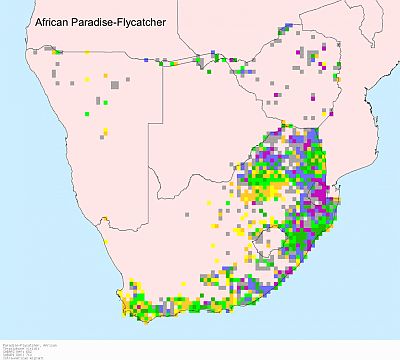
Habitat
Evergreen, coastal and riverine forests and bush, and suburban gardens.
Movements and migrations
It is a breeding migrant with two separate subspecies, each arriving in different areas and during different times of the year: T. v. grantii breeds around the coast of South Africa through to most of Mozambique. It arrives around September, staying until about April, although it varies greatly year-to-year. T. v. plumbeiceps occupies the rest of its southern African distribution, arriving mainly in October and also leaves during April.
Diet
It mainly eats invertebrates, such as moths, termite alates, beetles and flies, occasionally eating small berries. It uses a variety of foraging techniques, catching most of its prey on the wing, although it regularly gleans insects from leaves and branches.
Breeding
African Paradise Flycatchers are monogamous. The nest is built by both sexes. It consists of a small cup of twigs and bark held together with spider web, decorated with lichen and often a "trail" of spider web and leaves dangling from its base. Egg-laying season peaks from October-December. It lays 1-4 white eggs, which are incubated by both sexes for about 11-19 days. They change shifts every 20-60 minutes, although the female often does most of the incubating at night. The chicks are brooded almost constantly for the first day or so, while they are fed small portions of insect prey. As they get older, their parents brood and feed them less often until they leave the nest at about 10-16 days old. They stay in a family group with their parents until another clutch of eggs is laid, at which point they become fully independent.
Call
The territorial male has varied songs, it usually gives a loud, rippling phrasetwee-tiddly-te-te. Contact call is a simple zeet-zwayt. Alarm call, zwayt, shorter, higher pitched and raspier than call note. Listen to Bird Call.
Status
Common summer breeding visitor or resident, present all year in the east and north-east.
Order: Passeriformes. Family: Monarchidae
Description
The adult male African Paradise Flycatcher has very long tail streamers. It has a dark head, neck and underparts, and chestnut wings and tail. There is a prominent white wingbar. It has abright blue bill and eye-ring. The male loses its long tail out of the breeding season.
The female has a browner tint to the underparts and lacks the wingbar and tail streamers. She has a duller blue eye-ring and bill.
Juveniles are similar to the female but duller.
Distribution
The African Paradise Flycatcher is a common breeder in Africa south of the Sahara Desert. In southern Africa, it is common from Zimbabwe, Mozambique and Botswana to large areas of South Africa. In southern Africa, it is common from Zimbabwe, Mozambique and Botswana to large areas of South Africa, all the way down to Cape Town. A common summer visitor along the southern coast and eastern parts of South Africa.

Habitat
Evergreen, coastal and riverine forests and bush, and suburban gardens.
Movements and migrations
It is a breeding migrant with two separate subspecies, each arriving in different areas and during different times of the year: T. v. grantii breeds around the coast of South Africa through to most of Mozambique. It arrives around September, staying until about April, although it varies greatly year-to-year. T. v. plumbeiceps occupies the rest of its southern African distribution, arriving mainly in October and also leaves during April.
Diet
It mainly eats invertebrates, such as moths, termite alates, beetles and flies, occasionally eating small berries. It uses a variety of foraging techniques, catching most of its prey on the wing, although it regularly gleans insects from leaves and branches.
Breeding
African Paradise Flycatchers are monogamous. The nest is built by both sexes. It consists of a small cup of twigs and bark held together with spider web, decorated with lichen and often a "trail" of spider web and leaves dangling from its base. Egg-laying season peaks from October-December. It lays 1-4 white eggs, which are incubated by both sexes for about 11-19 days. They change shifts every 20-60 minutes, although the female often does most of the incubating at night. The chicks are brooded almost constantly for the first day or so, while they are fed small portions of insect prey. As they get older, their parents brood and feed them less often until they leave the nest at about 10-16 days old. They stay in a family group with their parents until another clutch of eggs is laid, at which point they become fully independent.
Call
The territorial male has varied songs, it usually gives a loud, rippling phrasetwee-tiddly-te-te. Contact call is a simple zeet-zwayt. Alarm call, zwayt, shorter, higher pitched and raspier than call note. Listen to Bird Call.
Status
Common summer breeding visitor or resident, present all year in the east and north-east.
- Flutterby
- Posts: 44150
- Joined: Sat May 19, 2012 12:28 pm
- Country: South Africa
- Location: Gauteng, South Africa
- Contact:
African Paradise Flycatcher Photos
710. African Paradise Flycatcher Terpsiphone viridis (Afrikaanse Paradysvlieëvanger)
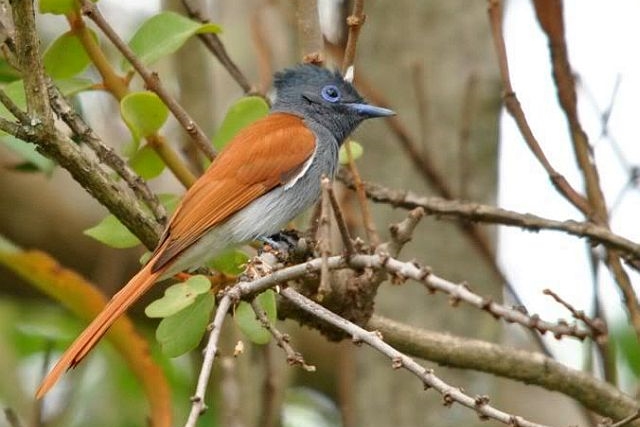 © lowveldboy
© lowveldboy
 © Duke
© Duke
Walter Sisulu National Botanical Gardens, Johannesburg
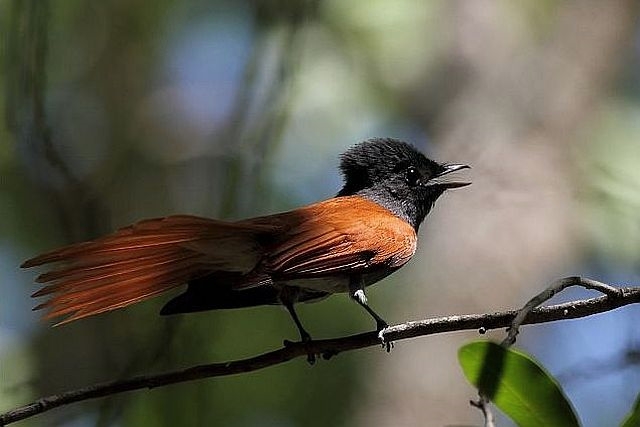 © Duke
© Duke
 © Duke
© Duke
Female
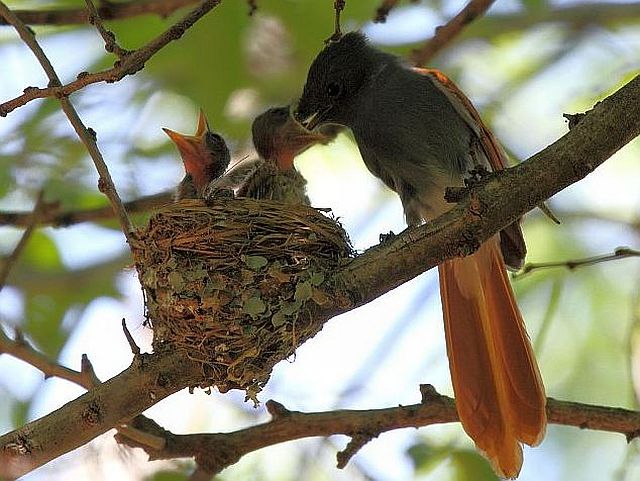 © Duke
© Duke
Female
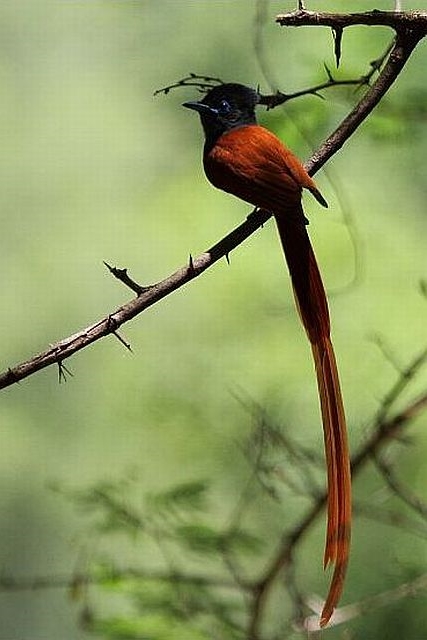 © Duke
© Duke
Male
 © Sprocky
© Sprocky
Male
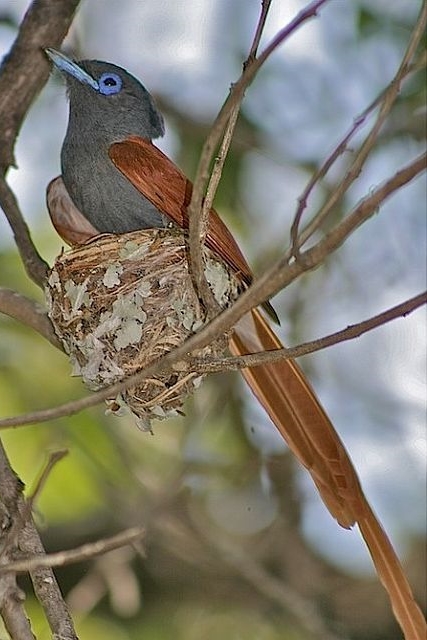 © ExFmem
© ExFmem
Breeding male
 © ExFmem
© ExFmem
Breeding male on nest
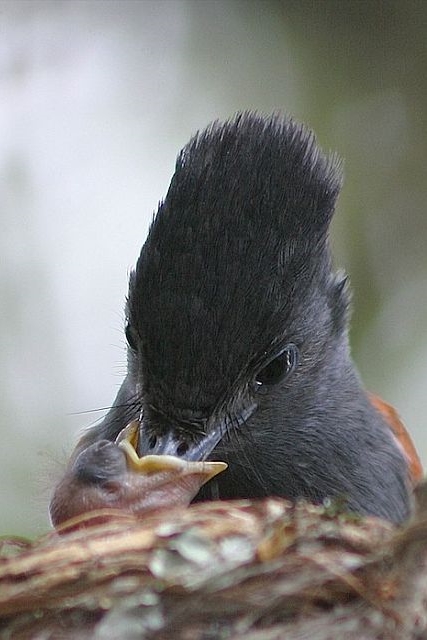 © ExFmem
© ExFmem
Female feeding chick
Links:
http://sabap2.adu.org.za/docs/sabap1/710.pdf
http://sabap2.adu.org.za/species_info.p ... #menu_left
De Castro J, De Castro M 2016. Cooperative breeding in the African Paradise Flycatcher. Biodiversity Observations, Vol 7.9:1-3.
 © lowveldboy
© lowveldboy © Duke
© DukeWalter Sisulu National Botanical Gardens, Johannesburg
 © Duke
© Duke © Duke
© DukeFemale
 © Duke
© DukeFemale
 © Duke
© DukeMale
 © Sprocky
© SprockyMale
 © ExFmem
© ExFmemBreeding male
 © ExFmem
© ExFmemBreeding male on nest
 © ExFmem
© ExFmemFemale feeding chick
Links:
http://sabap2.adu.org.za/docs/sabap1/710.pdf
http://sabap2.adu.org.za/species_info.p ... #menu_left
De Castro J, De Castro M 2016. Cooperative breeding in the African Paradise Flycatcher. Biodiversity Observations, Vol 7.9:1-3.
Family Corvidae (Crows)
Corvidae is a cosmopolitan family of oscine passerine birds that contains the crows, ravens, rooks, jackdaws, jays, magpies, treepies, choughs and nutcrackers. There are approximately 120-125 species in the Corvidae family depending on individual classifications, and these birds are found throughout much of the world in a wide range of habitats, but are absent from the harshest polar regions as well as the tip of South America.
There is great variation among Corvidae birds, particularly in plumage – some species are simply colored or just one color, typically black, while others are far more colorful and brightly marked – shades of blue and purple are especially prominent but are not found on all species.
Corvids are large to very large passerines with a robust build, strong legs and they have nostrils covered by bristle-like feathers. Corvids have strong, stout bills and large wingspans. The family includes the largest members of the passerine order.
Despite this range in appearance, however, these passerines do share many characteristics, such as:
•Strong, stout bills with rictal bristles at the base for most species
•Genders similar in size and appearance
•Generally non-migratory and stay in same range year-round
•High intelligence, including behaviors such as caching food, using tools, playing and cooperating as a group
The natural diet of many corvid species is omnivorous, consisting of invertebrates, nestlings, small mammals, berries, fruits, seeds, and carrion. However, some corvids, especially the crows, have adapted well to human conditions and have come to rely on anthropogenic foods.
Many species of corvid are territorial, protecting territories throughout the year or simply during the breeding season. The partner bond in corvids is extremely strong and even lifelong in some species. Males and females build large nests together in trees or on ledges. The male will also feed the female during incubation. The nests are constructed of a mass of bulky twigs lined with grass and bark. Corvids can lay between 3 and 10 eggs, typically ranging between 4 and 7. The eggs are usually greenish in colour with brown blotches. Once hatched, the young remain in the nests for up to 6–10 weeks depending on the species. Corvids provide biparental care.
The true crows of the genus Corvus make up a third of the species in the Corvidae family. Corvus species are all black or black with little white or grey plumage.
There is great variation among Corvidae birds, particularly in plumage – some species are simply colored or just one color, typically black, while others are far more colorful and brightly marked – shades of blue and purple are especially prominent but are not found on all species.
Corvids are large to very large passerines with a robust build, strong legs and they have nostrils covered by bristle-like feathers. Corvids have strong, stout bills and large wingspans. The family includes the largest members of the passerine order.
Despite this range in appearance, however, these passerines do share many characteristics, such as:
•Strong, stout bills with rictal bristles at the base for most species
•Genders similar in size and appearance
•Generally non-migratory and stay in same range year-round
•High intelligence, including behaviors such as caching food, using tools, playing and cooperating as a group
The natural diet of many corvid species is omnivorous, consisting of invertebrates, nestlings, small mammals, berries, fruits, seeds, and carrion. However, some corvids, especially the crows, have adapted well to human conditions and have come to rely on anthropogenic foods.
Many species of corvid are territorial, protecting territories throughout the year or simply during the breeding season. The partner bond in corvids is extremely strong and even lifelong in some species. Males and females build large nests together in trees or on ledges. The male will also feed the female during incubation. The nests are constructed of a mass of bulky twigs lined with grass and bark. Corvids can lay between 3 and 10 eggs, typically ranging between 4 and 7. The eggs are usually greenish in colour with brown blotches. Once hatched, the young remain in the nests for up to 6–10 weeks depending on the species. Corvids provide biparental care.
The true crows of the genus Corvus make up a third of the species in the Corvidae family. Corvus species are all black or black with little white or grey plumage.
Family Corvidae (Crows) Index
Family Corvidae (Crows)
Corvus splendens House Crow 549
Corvus capensis Cape Crow 547
Corvus albus Pied Crow 548
Corvus albicollis White-necked Raven 550
Corvus splendens House Crow 549
Corvus capensis Cape Crow 547
Corvus albus Pied Crow 548
Corvus albicollis White-necked Raven 550


